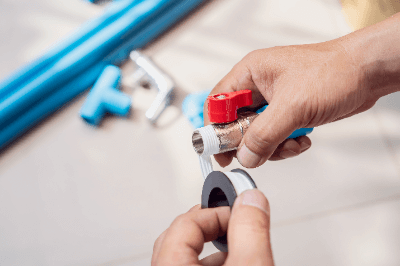What Is a Teflon Seal?

A Teflon seal is a material (sealing material) made of a fluoropolymer called Teflon or PTFE (polytetrafluoroethylene) that is used to maintain sealing properties.
A seal is broadly defined as a plastic material that seals a gas or liquid leak, but is also referred to as a packing or gasket. Packing and gasket refer to parts that are sandwiched together to create a tight seal at a joint.
However, “seal” is not limited to parts; it also includes tape that is wrapped around a joint.
Uses of Teflon Seals
Teflon seal is used, for example, in the form of tape that is wrapped around the threads of a piping joint to ensure a tight seal. This is also known as “thread sealing tape.
It is also used as a gasket to seal vacuum flanges to prevent atmospheric inflow. Another application is to prevent dust from entering from the outside (dust seal).
Thus, Teflon seals are widely used in hydraulic and hydraulic equipment under low to high pressure conditions, mainly to prevent leakage of fluids such as oil and water.
Characteristics of Teflon Seals
Teflon seals are used in a wide range of applications because of their excellent heat and cold resistance (thermal properties), insulation properties (electrical properties), and chemical stability and resistance to a wide range of chemicals (chemical properties). Teflon’s properties, which are not found in other industrial materials, make it suitable for use in harsh conditions, ranging from vacuum to high-pressure environments.
Teflon is highly stable against acids, alkalis, and organic solvents, and rarely corrodes or swells. It also exhibits strong resistance to ozone gas. In addition, Teflon has no electrical polarity (nonpolar) due to the symmetry of its molecular structure.
Therefore, parameters such as dielectric constant and power factor are constant regardless of temperature and frequency, and insulation resistance is extremely high. Even under high voltages of several tens of kilovolts, Teflon can demonstrate its performance without losing its insulating properties (→ similar to the principle of Teflon coating).
Molecular Structure of Teflon
Teflon is a thermoplastic polymer (softens and can be molded by heat) composed of fluorine elements and carbon chains. Its unique chemical, electrical and thermal properties are due to the molecular structure of Teflon itself.
Fluorine is stably bonded to the carbon chains in Teflon. The stability of this fluorine-carbon bond and the symmetry of the molecular structure are the source of Teflon’s performance.
It does not desorb even when heated up to a certain temperature, and its properties as Teflon are hardly lost. However, the melting point of Teflon is 327°C. Above this temperature, however, Teflon becomes gelatinous, and its mechanical properties drop sharply.
Types of Teflon Seals
Teflon seals come in a wide variety of forms, including gaskets, gaskets, and tapes. Some tapes are commonly referred to as VALQUA TAPE.
This is a tape-type sealing material manufactured by VALQUA Corporation, and its product name is TAPE SEAL®. It is often referred to as “Teflon seal” to refer to sealing Teflon tape made by companies other than VALQUA Corporation. In addition to tape-type sealing materials, fine thread-type sealing materials are also available.
Other Information About Teflon Seal
1. Teflon and PTFE as Names
Teflon® is a product name developed by DuPont of the United States in the 1930s. It generally refers to resins made of polytetrafluoroethylene (PTFE).
Although “Teflon” is currently used as a common name for PTFE, it is only a product name. In applications that are not DuPont products or not authorized by DuPont, the Teflon name is not used, but PTFE is used.
2. When Used as “Thread Sealing Tape” for Teflon Seal
Thinly wrap the tape around the threads of piping to be joined with screws, etc., and then screw in the parts to be joined. In this way, the high plasticity of the Teflon seal causes it to deform, tightly sealing the gap between the threads and creating a high-performance seal.
Due to the low friction of Teflon, the force required when screwing in is also tolerable.